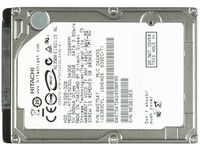Next-Gen 7,200 RPM Notebook Hard Drives
Hitachi Travelstar 7K320
The first of our four new 7,200 RPM notebook drives is Hitachi’s Travelstar 7K320, which represents the biggest generation change compared to its predecessor, the Travelstar 7K200. The 200 GB to 320 GB jump represents a 60% capacity increase, as Hitachi skipped the 250 GB capacity point. On this model, 160 GB is stored per platter, which means that this drive reaches its maximum capacity utilizing two platters within the 9.5 mm drive height.
Hitachi offers five different capacity points: 320 GB, 250 GB, 160 GB, 120 GB and 80 GB, and there are three different model lines, which differ in terms of interface (SATA/150 or SATA/300) and durability. The so-called “standard models” run Serial ATA/300, while the BDE drives, supporting hardware encryption (Bulk Data Encryption), are limited to SATA/150. The Enhanced Availability (EA) models are designed for 24/7 operation and run at SATA/300 connection speeds. Hitachi does not offer drives with an integrated free fall sensor to park the heads when unusual acceleration is detected.
Performance
All models have a 16 MB cache memory, 7,200 RPM spindle speed and a specified 12 ms average read seek time. We measured an effective 15.9 ms, which isn’t a record, as Seagate’s Momentus 5400.4 at 5,400 RPM manages to reach the same figure.
While the Travelstar 7K320 is the slowest of the four high-performance notebook drives when it comes to read and write throughput, it is still clearly faster than 5,400 RPM drives, and does very well in the PCMark05 Windows XP startup benchmark, where it outperforms the competition. Still, performance isn’t the reason to purchase this drive.
This drive offers nice performance per watt in our streaming read benchmark, and above-average results in the workstation I/O test. We used both to calculate an overall performance per watt rating.
Efficient Power Management
Get Tom's Hardware's best news and in-depth reviews, straight to your inbox.
Hitachi’s Travelstar drives are more advanced than its competitors when it comes to power consumption. The drive’s idle power requirement of 0.91 W is one of the best results for active idle states. However, Hitachi also implements low-power idle states, which reduce the drive’s power consumption while not stopping the spindle motor.
The data sheet specifies a 1.0 W active idle power, which equals exactly the 1.00 W we measured. It also mentions a performance idle state, but we found it more interesting to look at low power idle, where Hitachi states a 0.8 W power requirement. We had the drive idle for 10 minutes to verify this number, and we measured an idle power requirement of 0.84 W, which almost equals Hitachi’s numbers. This isn’t as low as the 5K320 and the 7K200 Travelstar drives got, but it’s still a very acceptable result for a 7,200 RPM drive. The 3.1 W peak power is also a great result, but the unit cannot hide its power consumption when a defined stream is requested, such as when playing DVD video. The Travelstar 7K320 required 1.6 W on average, which is only beat by the WD Scorpio Black.
Current page: Hitachi Travelstar 7K320
Prev Page Hard Drives vs. Flash SSDs Next Page Samsung Spinpoint MP2 HM251JJ

